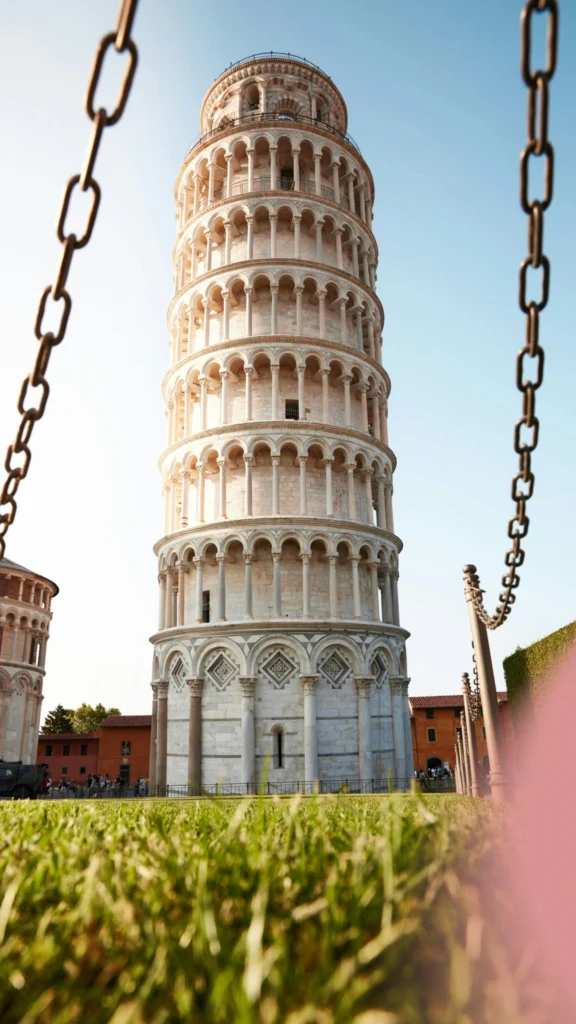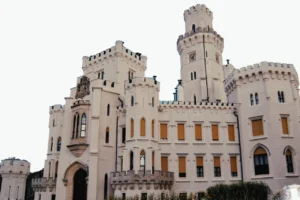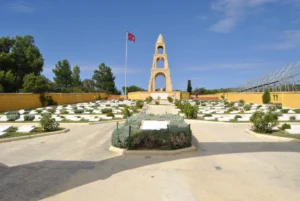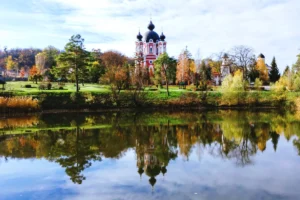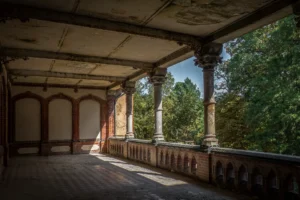Leaning Tower of Pisa: History and Architectural Secrets

Discover the story behind the Leaning Tower of Pisa's tilt, architectural details, and rich history. Are you ready to unveil the secrets of this iconic landmark?
In the year 11173, people on the crowded marketplace of Pisa watched with great excitement and astonishment a gigantic structure rising towards the sky. With each additional floor, this tower became the pride of the city, while no one could have predicted that centuries later it would turn into an engineering puzzle...
Can the pursuit of perfection in a structure make it world-famous? The story of the Leaning Tower of Pisa provides exactly the answer to this question and takes us back centuries to the days when a marvel of marble was being built.
Located in the enchanting heart of Tuscany, Pisa stands out as one of the most special cities in the world with its historical texture, deep-rooted cultural heritage, and architectural masterpieces. However, what truly makes the city unique worldwide is undoubtedly the Leaning Tower of Pisa, which captivates millions of visitors with its inclined stance.
This famous bell tower, rising in the Field of Miracles (Piazza dei Miracoli), attracts attention not only with its inclination but also with its elegant architecture and centuries-old history. Listed in the UNESCO World Heritage List, the tower is both an engineering mystery and an architectural masterpiece.
In this article, we will explore every detail of the Leaning Tower of Pisa's fascinating history, its architecturally flawless details, years of restoration work, and the unique experiences it offers its visitors. Additionally, by addressing the historical treasures around the tower and the enchanting legends passed down orally, we will delve together into the depths of this iconic structure.
If you are ready, let's step into the magical world of this leaning marvel of Italy!
Historical Background and Architectural Features
The Construction and Inclination Process of the Leaning Tower of Pisa: A Challenge for Engineering and Time
The Leaning Tower of Pisa began to be built in 1173 as a magnificent bell tower. At that time, the Republic of Pisa wanted to showcase its wealth and power to the entire world, and this tower was designed precisely to serve that purpose. However, no one could have predicted that it would become one of history's most interesting architectural stories.
The construction period lasted about 200 years, during which many architects took over the project. In the initial phase, the architect Bonanno Pisano designed the tower. However, in the later stages of construction, architects like Giovanni di Simone and Tommaso Pisano took over the project and completed the structure. This long and interrupted process led to a blending of different architectural styles in the tower.
The Elegance of Marble and the Treachery of the Ground
The tower was constructed using white marble and sturdy stones, giving it an elegant aesthetic. The shiny marble surface dazzles under the sunlight, while the durable stones contribute to the building's longevity. With a height of 56 meters, the tower formed a majestic silhouette in the Field of Miracles.
However, this engineering marvel encountered an unexpected problem when the construction reached the third floor: ground subsidence. The soft and unstable ground structure of Pisa caused a significant tilt in the tower's foundation. While the first floors rose straight up, the tilt became visible starting from the third floor.
The architects tried to balance the tilt by making structural changes in the upper floors to solve the problem. However, these efforts could not completely stop the tower from leaning. The ground conditions and the tower's weight combined, causing the structure to gain its iconic tilt and acquire the characteristic appearance we know today.
Thanks to this apparent engineering flaw, the Leaning Tower of Pisa became one of the most interesting and eye-catching structures in the world. Every year, millions of tourists flock to Italy to see this leaning marvel.
The Dance of Stone and Marble: Architectural Secrets of the Leaning Tower of Pisa
The Leaning Tower of Pisa is considered one of the most impressive examples of Romanesque architecture. Each floor features elegant columns, detailed arches, and striking ornamentations. These elements prove that the tower is not only an engineering masterpiece but also an aesthetic work of art. Round arches and symmetrical windows are distinctive features of the Romanesque style that manifest themselves on every floor of the tower.
Layer by Layer Beauty
The tower consists of a total of 8 floors, each displaying unique elegance. The columned galleries on each level add lightness to the structure, while marble details complete the architectural grace. The columns and arches surrounding the tower, combined with daylight, offer a captivating visual spectacle.
The Melody of 7 Bells
At the top of the tower, there are 7 bells, which play both an aesthetic and functional role. Each bell rings in a different note, creating melodies that echo throughout the city during religious ceremonies. The strategic placement of the bells is also of great importance for the structural balance of the tower.
Tilt and Balance
Today, the tilt angle of the Leaning Tower of Pisa is approximately 3.99 degrees. At first glance, this tilt might appear to be a mistake, but it is actually the most important feature that enhances the uniqueness and appeal of the structure. Thanks to years of restoration and engineering work, this tilt has been kept under control, ensuring the tower's safety.
Perfect Materials, Timeless Durability
The white marble and sturdy stones used in the tower's construction have given it both an elegant appearance and longevity. Continuous maintenance and engineering work have ensured the tower's preservation and carried this timeless structure into the present day.
The Leaning Tower of Pisa is living proof of how aesthetic design and engineering can combine in perfect harmony to create a marvel. With every detail, this structure brings together history, art, and engineering, offering visitors not just a tower, but a story. 🌍✨
A Timeless Marvel: The Restoration Adventures of the Leaning Tower of Pisa
The Tower's Tilt Problem and Initial Interventions
The tilt problem of the Leaning Tower of Pisa was noticed when construction reached the third floor, and this condition has led to efforts to keep the tower standing over the centuries. The weak ground structure and unstable foundation caused the building to lean, but this also made the tower more famous.
Especially in the 1990s, when the tilt reached a critical level, the risk of the tower collapsing entirely increased. As a result, the tower was closed to the public and entered an urgent restoration process. The primary goal was to control the tilt and prevent further damage to the structure.
The Restoration Process: A Triumph of Engineering and Technology
Restoration work that began in 1990 and lasted 11 years is considered one of the most important engineering projects in history. Throughout the process, modern engineering techniques and precise measurement devices were used to reduce the tower's tilt by approximately 45 centimeters.
Important Steps of the Restoration:
- Foundation Strengthening: Deeper support structures were installed in the ground.
- Ground Stabilization: The soft ground beneath the building was strengthened using injection techniques.
- Tilt Balancing: The weight distribution on the tower was recalculated and balanced.
- Precise Monitoring Systems: Sensors capable of detecting even the slightest movements of the tower were installed.
During the restoration work, the original building materials were minimally altered, and the tower's historical texture was preserved with great care. This process went down in history as a perfect harmony between engineering and cultural heritage preservation.
UNESCO and Conservation Standards
Since the 1990s, the Leaning Tower of Pisa has been listed in the UNESCO World Heritage List and has been protected as a global cultural heritage site. Restoration and maintenance work have been carried out in accordance with UNESCO's stringent standards.
Regular maintenance work and continuous monitoring systems ensure the tower's stability and safety. In particular, preserving the tower's historical texture is considered one of the fundamental principles of the restoration work.
The completion of the restoration in 2001 and the reopening of the tower to visitors were met with great joy worldwide. Today, the Leaning Tower of Pisa welcomes its visitors more safely than ever.
Conservation Measures for the Future
To enhance the Leaning Tower of Pisa's resistance to time, continuous monitoring and maintenance work are ongoing.
- Monitoring Ground Movements: Thanks to precise sensors, ground movements are tracked in real-time.
- Measures Against Climate Change: The effects of climate change on the structure are analyzed, and conservation methods are developed.
- Natural Disaster Resilience: Structural reinforcement work against earthquakes and other natural disasters is ongoing.
The tower's legendary tilt continues to be preserved thanks to modern engineering techniques and meticulous restoration work. The Leaning Tower of Pisa is not just a building; it is a tangible symbol of human determination, engineering expertise, and cultural heritage preservation efforts.
Future generations will be able to admire this magnificent structure and see the deep traces of history with their own eyes. 🏛️✨
Visitor Experience and Practical Information
Tickets and Visiting Hours
One of the most important steps for those who wish to visit the Leaning Tower of Pisa is to plan their tickets and visiting hours.
-
Reservation: Since the Leaning Tower of Pisa is visited by millions of tourists each year, it is very important to reserve tickets online in advance. Tickets can be easily obtained through the official website, allowing you to avoid long queues.
-
Ticket Prices: Ticket prices may vary seasonally. Especially during the summer months and holiday periods, demand increases, leading to higher prices. There are discounted ticket options available for students, seniors, and groups.
-
Visiting Time: Climbing to the top of the Leaning Tower of Pisa is usually limited to 30 minutes. This time is confined to a short guided tour, providing visitors with the opportunity to see all floors of the tower and learn about its history.
Best Time to Visit
Choosing the right time is important to avoid peak visiting periods and to have a more peaceful visiting experience.
-
Early Morning Hours: Visiting the tower early in the morning is ideal to beat the crowds and enjoy the tower in a quieter environment.
-
Afternoons and Sunsets: Visiting the tower in the late afternoon or during sunset is a perfect time to take unforgettable photos with unique views. Under the golden lights, the tower's magnificent silhouette offers visitors enchanting moments.
Transportation
Reaching the Leaning Tower of Pisa is quite easy from the city center.
-
Airport: From Galileo Galilei Airport, you can easily reach Pisa city center by bus or train. The journey from the airport to the city center takes about 5-10 minutes.
-
Train: Pisa Centrale train station is located in the city center and is only 20 minutes walking distance from the tower. Train services are regular, and both local and international trains provide easy access.
-
Public Transport: Bus and tram lines within the city provide easy access to the Leaning Tower of Pisa. Additionally, there are bicycle rental services in the city, allowing visitors to reach the tower while exploring the surroundings.
Visitor Tips
There are some practical tips to consider when visiting the Leaning Tower of Pisa.
-
Comfortable Shoes: Since you need to climb about 294 steps to reach the tower, it is important to wear comfortable and supportive shoes. Long and steep stairs can make your walk tiring.
-
Photography: There are various spots on the Field of Miracles to take photos of the tower from different angles. Experiment with different perspectives to capture the most beautiful shots.
-
Eating and Drinking: Don't forget to taste authentic Tuscan delights at the restaurants and cafes around the Field of Miracles. Local dishes are a perfect opportunity to experience the rich flavors of Italian cuisine.
-
Souvenir Shopping: In the souvenir shops in the area, you can buy memories themed around the Leaning Tower of Pisa and local handicraft products. This way, you can immortalize the memory of your visit.
Safety and Rules
There are certain rules and regulations in place for the safety of visitors.
-
Education and Information: Visitors are asked to avoid movements that could damage the structure. Considering the tower's tilt and structural sensitivity, adhering to safety measures is important.
-
Guided Tours: Guided tours led by professional guides provide in-depth information about the tower's history and architectural features. Guided tours enhance your visit experience and make it more enriching and meaningful.
-
Restricted Areas: Access to certain parts of the tower may be prohibited. Attempting to enter these areas can pose safety risks, so it is important to follow the rules.
Environment and Cultural Riches: The Fascinating World of the Field of Miracles
The Leaning Tower of Pisa is not only an architectural marvel on its own but also an important part of a rich cultural complex. The Field of Miracles (Piazza dei Miracoli) hosts, in addition to this unique structure, many other significant works filled with history and art. Each one of these buildings reflects Pisa’s religious, cultural, and artistic identity, offering visitors an unforgettable experience.
Pisa Cathedral (Duomo di Pisa)
Considered a masterpiece of Romanesque architecture, the Duomo di Pisa dazzles with its elegant white marble facade and fine details. Built in 1063, this magnificent cathedral symbolizes the power and religious dedication of the Republic of Pisa.
- Interior: Walls adorned with frescoes, magnificent mosaics, and massive columns virtually transport visitors on a time journey.
- Artworks: The sculptures by the famous artist Giovanni Pisano are among the most striking details of the cathedral.
Baptistery (Battistero di San Giovanni)
The Baptistery holds the title of Italy's largest baptistery and is renowned for its perfect acoustics.
- Architectural Details: Its rounded structure, large columns, and elegant dome showcase impressive aesthetics.
- Acoustic Experience: Visitors can experience the building's unique echo effects during acoustic demonstrations conducted by guides.
Camposanto (Holy Cemetery)
Camposanto is one of the most mystical and impressive structures in the Field of Miracles. According to legend, the soil here was brought from Jerusalem during the Crusades.
- Frescoes and Mosaics: Medieval frescoes and mosaics provide visitors with an artistic atmosphere.
- Peaceful Atmosphere: Camposanto offers visitors a peaceful combination of history and art.
Eating and Drinking and Shopping: Italian Delicacies and Memories
The area around the Field of Miracles is a paradise for those who want to explore Tuscany’s rich culinary culture.
- Gourmet Stops: Handmade pasta, Tuscan wines, and traditional sweets can be enjoyed in the restaurants and cafes around the square.
- Shopping Experience: Souvenir shops offer a wide range of options from Leaning Tower of Pisa-themed products to handmade Italian ceramics.
Museo dell'Opera del Duomo (Cathedral Museum)
Museo dell'Opera del Duomo houses valuable artworks brought from the cathedral and the baptistery.
- Art Collections: Sculptures, paintings, and religious objects offer visitors the opportunity to get to know the artistic richness of the Field of Miracles more closely.
- Historical Archives: Documents and old manuscripts displayed in the museum shed light on Pisa’s history.
Pisa University and Sinagoga dei Scolopi
- Pisa University: The Pisa University, one of Europe's oldest universities, reflects the city’s academic and intellectual spirit. Its historical buildings and modern campus attract visitors’ interest.
- Sinagoga dei Scolopi: This synagogue, an important representative of Jewish culture in Pisa, impresses with its architectural details and historical significance.
Field of Miracles: An Experience Beyond Time
The Leaning Tower of Pisa and the surrounding buildings are fascinating not only for their architectural and artistic beauty but also for the stories and meanings they carry. Each building speaks to visitors from a different time period and conveys the rich cultural fabric of Italy.
If you are planning a visit to Pisa, appreciate every moment you spend on this square and enjoy the unique combination of history, art, and architecture.
Legends and Interesting Facts about the Leaning Tower of Pisa
Galileo Galilei's Experiments
The famous Italian scientist Galileo Galilei is said to have conducted his free fall experiments from the Leaning Tower of Pisa. These experiments played a crucial role in discovering the laws of gravity and motion. Galileo's experiments made a significant impact in the scientific world and laid the foundations of modern physics. By hosting Galileo's scientific work, the Leaning Tower of Pisa became a point where science and engineering converge.
One of the Most Photographed Structures in the World
The Leaning Tower of Pisa is among the most photographed tourist structures worldwide. Its inclined structure and unique architecture make it an indispensable subject for photographers and tourists. Every year, millions of photos are taken capturing the tower from various angles. These photos are widely shared on social media platforms, enhancing the tower's global fame.
"It Looks Like He's Supporting It" Poses
Each year, hundreds of thousands of people pose in positions that make it look like they are supporting the leaning part of the Leaning Tower of Pisa. Visitors try out various creative positions that emphasize the tower's tilt, resulting in fun and interesting photos. These kinds of photos highlight the tower's inclined structure while allowing visitors to create enjoyable memories.
The Future of the Tower and Tilt Control
The tilt of the Leaning Tower of Pisa is being continuously controlled thanks to increasing attention and modern engineering solutions. Nowadays, the tower's tilt is constantly monitored by engineers, and necessary measures are taken. In this way, interventions are made before the tilt progresses further, and the structure's stability is maintained. The Leaning Tower of Pisa demonstrates the success of technology and engineering in preserving architectural marvels.
Symbolic Meaning of the Tower
The Leaning Tower of Pisa holds great symbolic significance beyond being a bell tower. Its inclined structure symbolizes human errors and the unexpected impacts of nature, while also representing human creativity and engineers' resilience against nature. The tower carries profound messages about human history at the intersection of art and science.
To Summarize
The Leaning Tower of Pisa is not only an architectural structure but also a reflection of human creativity, engineering genius, and history. Every detail, every floor, and every angle tells its own story. This magnificent structure offers visitors not only a visual feast but also deep historical and cultural meanings. Visiting the Leaning Tower of Pisa provides an experience that carries traces of the past while offering hope and inspiration for the future.
Recommendations
-
Plan Your Visit in Advance: If you want to visit the Leaning Tower of Pisa, purchasing your tickets online in advance will make your visit more comfortable and enjoyable. Especially during peak seasons, reserving tickets in advance helps you avoid crowds.
-
Spend Half a Day in the Field of Miracles: In addition to visiting the tower, spending time in the Field of Miracles is ideal for exploring other important buildings and cultural treasures in the area. By visiting the cathedral, baptistery, and cemetery, you can learn more about the region’s history and art.
-
Discover Pisa’s Historical and Cultural Heritage: Pisa offers not only its tower but also a historic university, museums, and art galleries, representing a rich cultural heritage. By visiting other important sites in the city, you can explore Pisa's rich history and cultural diversity.
Additional Tips
-
Language and Communication: Knowing Italian will greatly facilitate your visit. However, thanks to English-speaking guides and staff, communication is generally smooth.
-
Local Events: Local events and festivals in Pisa can add an extra color to your visit. By participating in such events, you can experience local culture more closely.
-
Health and Safety: Pay attention to your health during long walks and stair climbs. Drink plenty of water and don’t forget to use sunscreen.
Final Thoughts
The Leaning Tower of Pisa is not only an architectural marvel but also a crossroads of history and engineering. During your visit, you will feel the magic of this unique structure with every step. Plan your visit and enjoy the discovery of this iconic symbol of Italy!
Note: Don't forget to check the official websites for ticket prices and visiting hours, as information may vary by season.
🗺️ Step into the Magical World of the Leaning Tower of Pisa!
Have you visited the Leaning Tower of Pisa before? 🏛️ Don't forget to share your experiences with us! We would be delighted to hear about your memories and feelings about this unique structure in the comments.
If you haven't visited Pisa yet, now is the perfect time to plan a visit and discover this fascinating structure up close! ✈️ Experiencing this iconic tower that defies time and gravity in person will be an unforgettable experience.
If you liked this article, share it with your friends so they can also discover this amazing story. 📲✨
Let's continue to explore the history and architecture of this leaning marvel together! 🌍💬
No comments yet.

